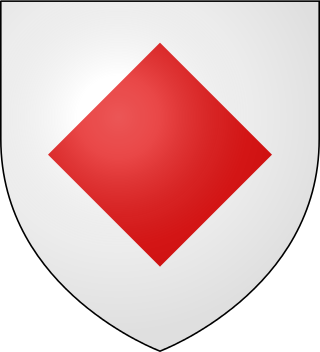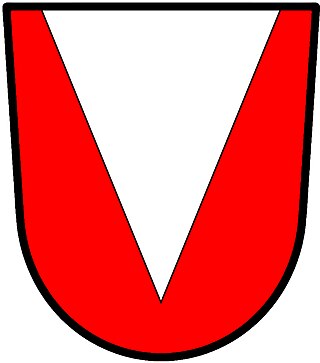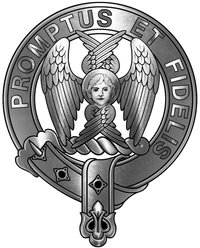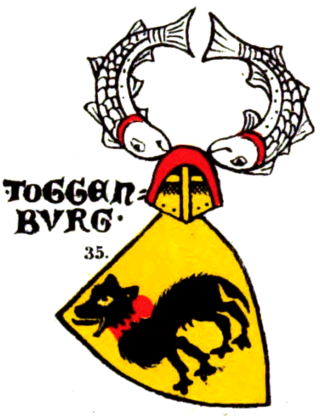
Heraldry is a discipline relating to the design, display and study of armorial bearings, as well as related disciplines, such as vexillology, together with the study of ceremony, rank and pedigree. Armory, the best-known branch of heraldry, concerns the design and transmission of the heraldic achievement. The achievement, or armorial bearings usually includes a coat of arms on a shield, helmet and crest, together with any accompanying devices, such as supporters, badges, heraldic banners and mottoes.

The coat of arms of the territory of Nunavut was granted by a warrant of Roméo LeBlanc, Governor General of Canada, dated 31 March 1999, one day before the territory of Nunavut, Canada, was created. The same document specified the flag of Nunavut.

Tincture is the limited palette of colours and patterns used in heraldry. The need to define, depict, and correctly blazon the various tinctures is one of the most important aspects of heraldic art and design.

The lines in heraldry used to divide and vary fields and charges are by default straight, but may have many different shapes. Care must be taken to distinguish these types of lines from the use of lines as charges, and to distinguish these shapes from actual charges, such as "a mount [or triple mount] in base," or, particularly in German heraldry, different kinds of embattled from castle walls.

In heraldry, variations of the field are any of a number of ways that a field may be covered with a pattern, rather than a flat tincture or a simple division of the field.

In heraldry, an ordinary is one of the two main types of charges, beside the mobile charges. An ordinary is a simple geometrical figure, bounded by straight lines and running from side to side or top to bottom of the shield. There are also some geometric charges known as subordinaries, which have been given lesser status by some heraldic writers, though most have been in use as long as the traditional ordinaries. Diminutives of ordinaries and some subordinaries are charges of the same shape, though thinner. Most of the ordinaries are theoretically said to occupy one-third of the shield; but this is rarely observed in practice, except when the ordinary is the only charge.
In British heraldry, sable is the tincture equivalent to black. It is one of the five dark tinctures called colours.

The lozenge in heraldry is a diamond-shaped rhombus charge, usually somewhat narrower than it is tall. It is to be distinguished in modern heraldry from the fusil, which is like the lozenge but narrower, though the distinction has not always been as fine and is not always observed even today. A mascle is a voided lozenge—that is, a lozenge with a lozenge-shaped hole in the middle—and the rarer rustre is a lozenge containing a circular hole in the centre. A field covered in a pattern of lozenges is described as lozengy; similar fields of mascles are masculy, and fusils, fusily. In civic heraldry, a lozenge sable is often used in coal-mining communities to represent a lump of coal.
Auguste Georges Vachon, is a Canadian officer of arms. He held the post of Saint-Laurent Herald of Arms in Ordinary at the Canadian Heraldic Authority from its foundation in 1988 until his retirement in 2000. Since then, he has served as Outaouais Herald of Arms Emeritus.

Portuguese heraldry encompasses the modern and historic traditions of heraldry in Portugal and the Portuguese Empire. Portuguese heraldry is part of the larger Iberian tradition of heraldry, one of the major schools of heraldic tradition, and grants coats of arms to individuals, cities, Portuguese colonies, and other institutions. Heraldry has been practiced in Portugal at least since the 12th century, however it only became standardized and popularized in the 16th century, during the reign of King Manuel I of Portugal, who created the first heraldic ordinances in the country. Like in other Iberian heraldic traditions, the use of quartering and augmentations of honor is highly representative of Portuguese heraldry, but unlike in any other Iberian traditions, the use of heraldic crests is highly popular.

In heraldry and heraldic vexillology, a blazon is a formal description of a coat of arms, flag or similar emblem, from which the reader can reconstruct the appropriate image. The verb to blazon means to create such a description. The visual depiction of a coat of arms or flag has traditionally had considerable latitude in design, but a verbal blazon specifies the essentially distinctive elements. A coat of arms or flag is therefore primarily defined not by a picture but rather by the wording of its blazon. Blazon is also the specialized language in which a blazon is written, and, as a verb, the act of writing such a description. Blazonry is the art, craft or practice of creating a blazon. The language employed in blazonry has its own vocabulary, grammar and syntax, which becomes essential for comprehension when blazoning a complex coat of arms.
A heraldic shield has been associated with the historic county of Sussex since the seventeenth century. The device, displaying six martlets or heraldic swallows on a shield, later formed the basis of the flag of Sussex and the armorial bearings granted to the county councils of East and West Sussex.

In heraldry, a pile is a charge usually counted as one of the ordinaries. It consists of a wedge emerging from the upper edge of the shield and converging to a point near the base. If it touches the base, it is blazoned throughout.

In heraldic achievements, the helmet or helm is situated above the shield and bears the torse and crest. The style of helmet displayed varies according to rank and social status, and these styles developed over time, in step with the development of actual military helmets. In some traditions, especially German and Nordic heraldry, two or three helmets may be used in a single achievement of arms, each representing a fief to which the bearer has a right. For this reason, the helmets and crests in German and Nordic arms are considered essential to the coat of arms and are never separated from it.

German heraldry is the tradition and style of heraldic achievements in Germany and the Holy Roman Empire, including national and civic arms, noble and burgher arms, ecclesiastical heraldry, heraldic displays and heraldic descriptions. German heraldic style is one of the four major broad traditions within European heraldry and stands in contrast to Gallo-British, Latin and Eastern heraldry, and strongly influenced the styles and customs of heraldry in the Nordic countries, which developed comparatively late. Together, German and Nordic heraldry are often referred to as German-Nordic heraldry.

The Heraldry Society of New Zealand, established in 1962, is the principal New Zealand learned society concerned with the scholarly study of heraldry.

The coat of arms of the London Borough of Camden were granted on 10 September 1965. The borough was formed by the merger of three former boroughs, namely the Metropolitan Borough of Hampstead, the Metropolitan Borough of Holborn and the Metropolitan Borough of St. Pancras, from whose arms elements were utilised in the arms of the new borough.

The coat of arms of the London Borough of Hackney is the official heraldic arms of the London Borough of Hackney, England. The coat of arms were granted on 25 July 1969.

Clan Carruthers is a Lowland Scottish clan of the Scottish Borders headed by their Chief, Simon Peter Carruthers of Holmains and is recognised as such by the Lord Lyon King of Arms.

The hound is a charge in classical heraldry. In English heraldry, the commonly used variant are the talbot, also blazoned as sleuth-hound, e.g. in the arms of Wolseley of Staffordshire, the greyhound and bloodhound. Rarely seen variants are the ratch-hound, the mastiff, the foxhound, the spaniel and the terrier. The "sea-dog" is a curious charge resembling the talbot but with scales, webbed feet and a broad tail, used in the arms of Stourton barony, presumably originally depicting a beaver . Similar charges include the wolf and the fox.















